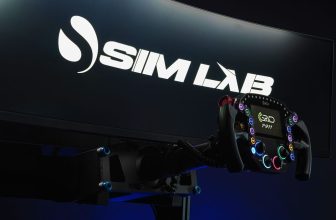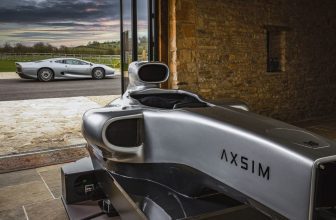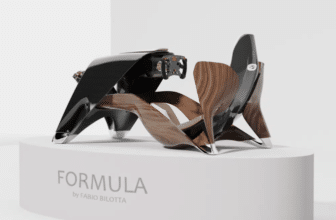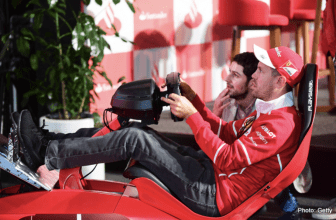This week we’ve got something new for you. We had a WEC champion test 4 SimRacing pedalset to get his opinion on each one. The champion in question is Gustavo Menezes. Loyal readers will remember that we already interviewed him a few months ago. Back then, he gave us his thoughts on the differences between SimRacing and the real thing.
Well, during that interview, Gustavo confided in me that he was in the process of preparing his chassis and would soon be needing a pedalset. I took the opportunity to ask him about his tastes in pedals and especially brakes. And here we are, 3 months later, at his place in Monaco, trying out 4 models that might meet his expectations.
Over and above the pleasure of spending time with a WEC champion, it was above all an opportunity to FINALLY get precise, concise and complete information on the expectations of a professional driver in terms of brakes. A driver who isn’t sponsored by a brand (even rarer) and who agrees to give us 2 days of his free time (now that’s divine). Make no mistake, in simracing as in real racing, brake management is one of the most important factors of all.
So I hope you’ll learn a lot from Gustavo, whom I’d like to thank warmly. In addition to the video, below you’ll find a summary of the tests we carried out and his feedback. I’ve also listed the different pedalset settings he liked. So you can try them out at home 😉
SimRacing pedalset selection criteria
OK, first thing, define the selection criteria. Because, as you know, there are hundreds of pedalsets out there. But in this jungle of offerings, very few have the features and quality that match the expectations of a pro rider. So what criteria should we set ourselves?
- The Price: We must stay around the €1,000 mark. The objective is to find a pedalset of very good quality but which remains accessible to SimRacers. So you will tell me, €1,000 is already a large amount. It’s true, but when you build a good simracing chassis, it’s in this price bracket that you’ll find yourself.
- That brands agree to lend us their pedalsets: Yes because hey, we’re not going to buy all the pedalsets in the world just for a video. And then have you seen the prices of hotels in Monaco? We were already ruined just with that ^^
- That it fits the driving style of the driver: Gustavo Menezes, he is a WEC driver who is driving the Peugeot 9X8 this year. He is also used to Formulas. We therefore needed pedalsets that could be adjusted to suit his tastes in terms of brakes. Because the brake pedals of LMH and Formulas are very different from the brakes of GT or rally cars for example. He had already explained to us in an interview that his brake is very short (approximately 2.5cm of travel) and very hard. Pushing 120Kg without warming up on his left leg poses no problem for him. And just with this criterion, we can already eliminate a very large number of simracing pedalsets.
A pedalset is like a pair of underpants..
… it’s personal! I can’t stress this enough: we all have different tastes and practices in SimRacing. And based on these tastes and practices, we’re going to make different choices in terms of pedalsets , but also in terms of settings. So it’s important to know where you want to go before making your own choice.
Gustavo is a WEC driver with Formula 1 experience. He’s looking for a pedalset that matches what he knows from his racing cars, as it’s on this type of braking that he feels comfortable and natural. The choice of equipment and settings he makes will not, for example, be at all suited to a simracer who only rides GT/Rallye. Or to a gamer who favors performance over realism in eSports. Take all this into account to make your own informed choice!
A big thank you to the brands who accepted the project
Based on the above criteria, we looked for models that would fit the bill. The problem is, not all brands are willing to put their pedalset head-to-head with the competition. Even more so when they’re going to be tested by a professional rider who speaks frankly and gives plenty of details. Luckily, 4 brands agreed to join our project. I’d like to take this opportunity to thank once again those who agreed to play the game. We know that this is a difficult exercise, which requires you to be really sure of your model’s qualities. So hats off to you!
Two days to test 4 models goes by very quickly! Gustavo spent between 2 and 3 hours on each model to find settings he liked. We generally reviewed all the possible settings for each pedalboard before taking stock of each (except when we found the ideal setting more quickly of course).
The simulation: iRacing
Les slopes : Sebring Short/Long – Silvestone
Vehicles : LMDh et F3
We start with the Venym Atrax
Gustavo is already familiar with this model, having spent long hours on it during the 24H du Mans Virtuelles. But he didn’t particularly like the setting that had been made for the event. It was a setting that corresponded more to the expectations of professional Simracers, and much less suited to a real driver. As a result, he told me he never felt comfortable on the Atrax brake during the race.
Luckily, I didn’t bring him a loaner pedalset, but my own. And since I have much the same taste in brakes as Gustavo, I’m confident I’ll be able to show him the good side of the Venym.

The Venym Atrax in a nutshell:
What better way to build a single-seater chassis than with a real single-seater manufacturer? Venym is a French company headed by Virgile Decoster, son of the founder of Mygale, the manufacturer of F4 and F3 Regional models.
Their Atrax pedalset is equipped with a spring-loaded gas pedal and Load Cell sensor. And their brakes are elastomeric and Load Cell 200Kg.
Gustavo’s assessment of the Atrax
After a few minor force adjustments (from 87Kg to 95Kg to 75Kg), we quickly found the optimum setting to satisfy Gustavo. A sexy design, solid pedals that look like they came straight out of a single-seater, and high-performance software. So many positive points for this Atrax. The pedalset is very versatile, thanks to the different elastomers and the spring that can be used to modulate the brake. And it has to be said that the Venym performs well on just about any terrain! However, Gustavo hasn’t found any area where the Venym really stands out. There isn’t one area where it really performs better than the others.
The brake is neither the shortest nor the longest, neither the smoothest nor the hardest, in short it’s an excellent compromise. And he was able to set very consistent times on the track very quickly. But it lacks a coup d’éclat to convince the driver.
After trying different configurations, it turns out that the “factory” green elastomers were the most successful. For the other settings, it came down to the details:
– The accelerator has been lengthened to reach its maximum travel.
– The brake calibration has been set to 75Kg.
– The brake curve remained almost linear with a slightly increasing curve on the last two segments.
Moving on to the Asetek Invicta
Gustavo and I had already talked about the Invicta, and he was eager to try it out. In the interview we’d done together in January, he’d shared with me what the Peugeot 9X8 brake looked like, and it seemed obvious to me that he’d be pleased with the Asetek model. It remains to be seen whether I was right.
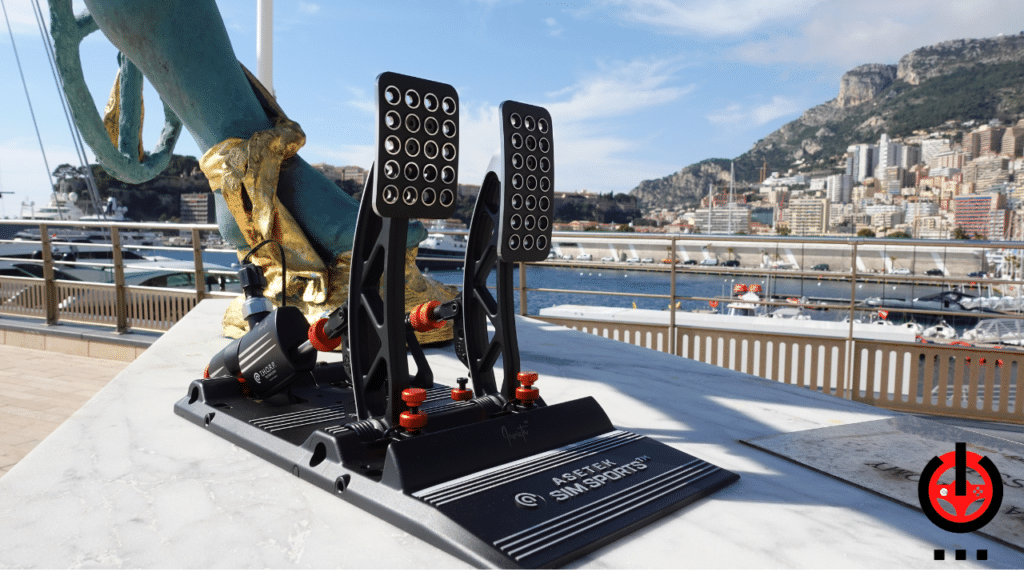
The Asetek Invicta in brief:
The Danes’ aim with the Invicta was to create a pedalset that truly replicated the travel and brake hardness of a real race car. And their knowledge of the subject comes directly from motor racing. The company’s CEO, André Eriksen, is himself a racing enthusiast with a good deal of track experience. And his son, Valdemar, was a GT3 driver before moving up to LMP3 in the Asian and European Le Mans Series.
The Invicta is equipped with a spring-loaded throttle and magnetic sensor. Its brake is equipped with a hydraulic cylinder,elastomers to change hardness and a 200Kg Load Cell sensor.
Gustavo’s assessment of the Invicta
If you’re a single-seater racer, whether Formula 1 or Prototype, this pedalset is for you. The combination of elastomer and hydraulics gives a nice brake hardness rise at the end of the travel. It took him 1 or 2 laps to really get used to the brake, which I had set a little too hard. Once he got used to it, Gustavo really appreciated the brake’s long travel and hardness, especially with the Long Travel Kit, which lengthens the brake stroke by 1 cm. The Invicta’s software is also a great asset, very precise and easy to learn, even though it’s comprehensive.
We tested a lot of settings to find exactly the feeling that Gustavo wanted to obtain. In the end this is the one that allowed us to get very, very close to the feeling it has on the real tracks:
– The yellow elastomer gave the ideal hardness.
– We used the Long Travel Kit to slightly extend the brake travel.
– Brake calibration set to 70 bars
– We left 2-3mm of free pedal travel by loosening the elastomer tightening ring by half a turn. – An exponential braking curve (as proposed by the software)
First choice: Venym Atrax or Asetek Invicta?
It’s time to make a first choice. Unsurprisingly, it’s the Invicta that wins this first round. The fact is, it only took 3 changes of rubber to find exactly the feel the driver was looking for. The progression in pedal hardness as weight is applied to the hydraulics means that braking can be modulated exactly as it would be in his race car.
High expectations for the Heusinkveld Ultimate
To be honest, Gustavo has a soft spot for Heusinkveld. It’s a brand he’s appreciated for many years, and he’s always wanted to try one out. And it’s fair to say that his expectations are high, as the brand’s reputation has been strong for years now. Let’s hope this reputation and these expectations don’t fail him in the end.

The Heusinkveld Ultimate in a nutshell:
i don’t think I need to introduce you to Heusinkveld, do I? The Dutch brand has forged a solid reputation in the world of SimRacing. Long the dominant name in the high-end Load Cell pedalset market, it now faces increasingly tough and innovative competition. So is the Ultimate still up to the challenge in terms of feel? Let’s find out.
An elastomer brake and Load Cell sensor that can accept a force of 140Kg (the sensor is 200Kg, but the rubber doesn’t go up that high). The gas pedal is spring-loaded and uses a Load Cell sensor.
Gustavo’s assessment of the Ultimate
This is the model with the longest brake pedal travel I tested over the two days. This travel has both good and bad sides. For example, it makes it very easy to modulate braking and play with the weight distribution in the car throughout a corner. On the other hand, it’s not at all what he’s used to in his racing cars. And the flexibility of the brakes was problematic.
On the hardest settings we tried, the modulation on the 60 to 70% of the beginning of braking was very good, but the 30 to 40% of the end of the travel suddenly went from very soft to very hard, with no modulation in the feel. For his part, Gustavo was looking to create a kind of “ramp-up” in brake hardness, as he’d managed to do on other models. But it wasn’t possible. His feeling is that this is the perfect pedalset for GT and rally cars, or for simracers who have never driven a race car and want to favor performance above all else.
We obviously tested all the settings offered by the brand in their user guide. Unfortunately none of these adjustments made it possible to obtain the feeling Gustavo was looking for. We therefore tried to make our own mixes in the gums until we found an “acceptable” compromise. Unfortunately, after filming, Heusinkveld very clearly asked us not to share the adjustments we made because they had not been validated by the brand.
The outsider Simagic P2000
We move on to the second hydraulically-operated pedalset in our trial. I’ve brought along this pre-set model, the one The French Simracer lent me for testing a few months ago… And which I never sent back… Sorry Lucas..
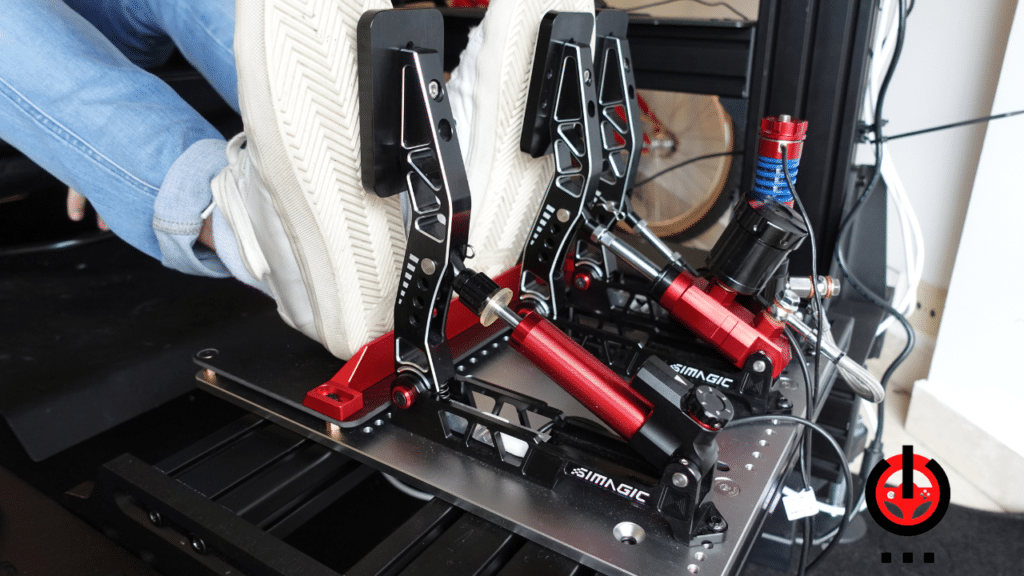
The Simagic P2000 in brief:
The Chinese brand, renowned for the uncompromising quality of its models, is the outsider in our test. Gustavo was not familiar with them, so had no particular expectations of this model.
The P2000’s throttle is operated by a hardness-adjustable damper with Load Cell sensor. And its brake is equipped with a hydraulic movement whose hardness is controlled by two adjustable springs. And its Load Cell sensor is either 100Kg or 200Kg , depending on the option you choose.
Gustavo’s assessment of the P2000
It got off to a rocky start on the Simagic simracing pedalset for one simple reason: the software doesn’t give you the weight or pressure you’re applying to the brake. So we had to calibrate “by feel”. As a result, we didn’t know exactly what force we were using. And when it comes to changing settings on the fly, this complicates things. I’ve had a chance to talk to Simagic since then, and this problem should be solved soon.
The second thing the WEC driver noticed was that the P2000 has two springs that can be quickly modified to completely change pedal travel and hardness. A very good point not only for versatility but also for the consistency of brake feel.
Whereas other pedalsets switch quite abruptly from soft to hard at the end of the brake stroke, the P2000 is very progressive and allows you to modulate the force very naturally, even when you’re at peak braking. The Simagic pedalset also has an advantage in terms of adaptability. It can really go from a very soft, long brake to a very short, hard brake in a matter of seconds. All without losing precision or feel for maximum control.
– The throttle travel has been increased to the maximum.
– Accelerator damper set to 4.
– Brake equipped with the green spring at the bottom (very hard) and the blue spring (hard) at the top.
– Calibration of the brake between 75 and 80Kg (this is an estimate because we had no display on the Simagic software).
– Linear braking curve.
Time to choose: Heusinkveld Ultimate or Simagic P2000?
Having seen the tests of both models, I don’t think you’ll be surprised by his choice. The P2000 comes out on top on several counts. Firstly, the ability to find exactly the feel he wanted, but also the ability to switch from one setting to another very quickly without losing feel quality.
Gustavo’s new SimRacing pedalset
With only the Simagic P2000 and Asetek Invicta left in the running, all that’s left to do is re-test. So we spent several more hours testing a ton more settings on each of them. And after another good half-hour discussing the two models and their pros and cons, Gustavo was finally able to make his choice.
| Asetek Invicta | Simagic P2000 | |
|---|---|---|
| What he liked | – Plug and Play – Perfect feel for Formulas/Protos – Sexy design and LED bar – Very neat and complete software | – Perfect feel – Versatile – Sexy design – Smooth throttle feel |
| What wasn’t so cool | – The footplate is too narrow and grips the shoe a little too tightly – Less versatile than the P2000 | – Plastic casing finish not up to scratch – Software doesn’t give brake forces |
Drum roll … If the two models are almost equal in terms of feel, it’s the P2000’s versatility and ease of setting changes that ultimately win the day. From now on, we’ll be using the Simagic P2000 on our chassis !
If you’re still looking for Your pedalset
For those who want to follow Gustavo, here’s the link to his Instagram: FollowGustavo. You’ll find his adventures on real and virtual tracks.
I’d like to take this opportunity to remind you that everyone has their own expectations and tastes when it comes to SimRacing pedalsets, and that just because a model appeals to me or Gustavo doesn’t necessarily mean it will appeal to you too. So take the time to understand what YOU want from your model before making an informed choice.
In any case, I hope these tests will give you a clearer idea of the world of pedalsets. For once, you’ve got the opinion not of simracers, but of a real professional rider, and that’s what I wanted. Because who better than a professional driver to tell us what’s good and what’s not in equipment that’s supposed to simulate real racing cars?
If we had to sum things up simply, the Venym performs well and is versatile, but didn’t offer Gustavo any real highlights. The Heusinkveld is very good for GT and Rally, but doesn’t suit his more Formula/Protos-oriented driving style. The Asetek, with its perfect brake feel for single-seaters. And last but not least, the Simagic, with a perfect brake feel that’s highly adaptable to all categories.
You can find the pedalsets by following the links right here 🙂
- Simagic P2000
- Asetek Invicta
- Heusinkveld Ultimate
- Venym Atrax
As always, we’ll be in the comments to discuss the fascinating world of pedalsets 🙂 See you soon below!



